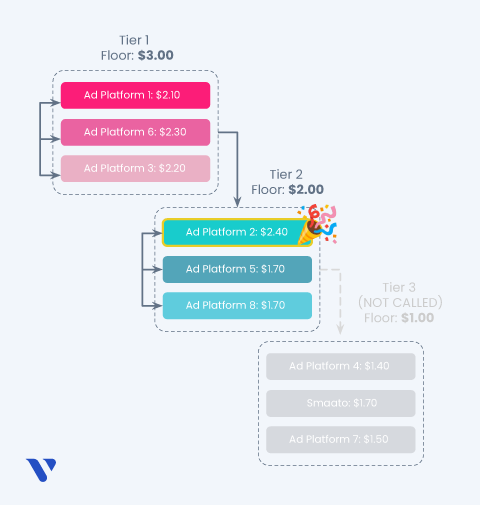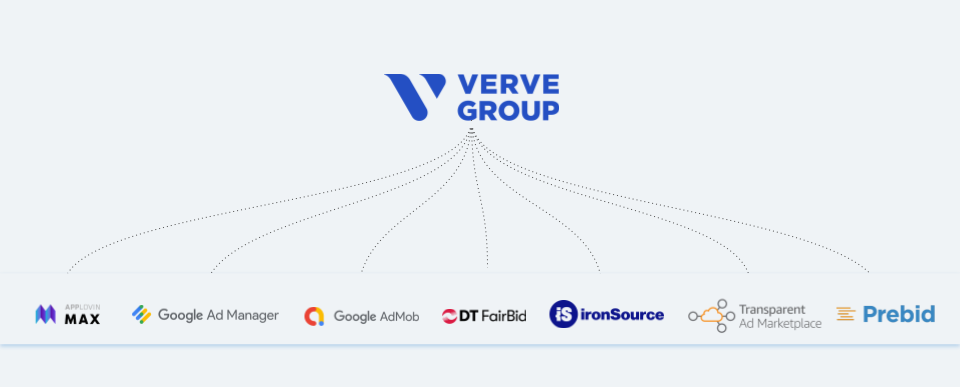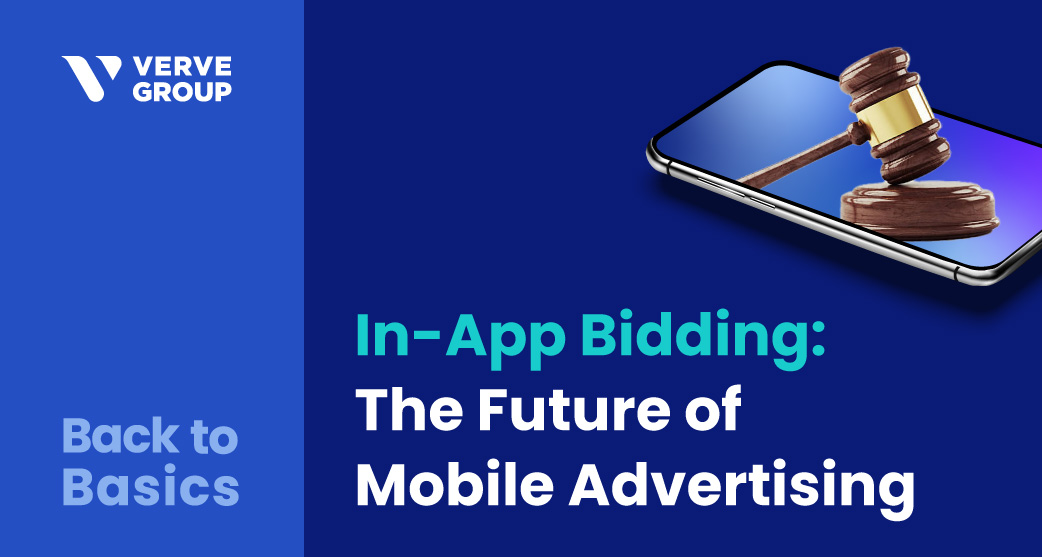How did mobile advertising evolve away from the waterfall method, and what’s the difference between header bidding and in-app bidding? And if the future of mobile ads is already here, what should publishers and advertisers be doing to make the most of today’s technology?
A brief history of programmatic ad inventory bidding
Don’t go chasing waterfalls
Once upon a time, publishers manually managed and optimized their ad inventory based on historical rates in a waterfall system. Publishers would set a floor price and prioritize their demand partners. If the first-priority partner couldn’t meet the floor price, the request would pass on to the next partner in line.
While the waterfall model was straightforward in theory, flaws and inefficiencies emerged. Among them:
- Reliance on historical performance data. Sometimes this historical data could be inaccurate, potentially leading to underpriced inventory and lower revenue.
- One ad buyer at a time. Simultaneous competition was impossible, hindering high-value ads and resulting in a lack of transparency. This meant advertisers might not have access to all the information needed to make a bid.
- Increased latency. The time it took for ad inventory to reach a willing buyer created undesirable downtime and opportunity costs.

These problems with efficiency and missed revenue created a demand for a new approach to managing ad inventory and bids. Enter header bidding.
What is header bidding?
Header bidding is a real-time pre-auction that enables multiple ad exchanges to bid on the same inventory simultaneously. The highest bid wins.
What’s in a name?
You might wonder how header bidding got its name, as well as how it’s different from in-app bidding. In technical terms, header bidding refers to the auction code used for sending requests to demand partners and defining rules for efficient auctions. It also appears in the HTML code for the web page header section.
Three reasons publishers choose header bidding
If you’re a publisher looking to maximize your ad revenue, header bidding is the clear choice. Why? Header bidding offers three major advantages when it comes to competition, efficiency, and transparency.
- More competition = higher prices. With header bidding, multiple buyers compete against each other to buy your ad inventory, resulting in higher prices. With waterfall bidding, a single buyer competes against preset price floors, often leading to lower prices.
- Bypass passbacks to avoid lost revenue. In addition, header bidding eliminates the need for revenue-sucking passbacks. Passbacks happen when an ad request is sent to an exchange but no bid is returned that meets the publisher’s price floor. The request is then “passed back” to the next exchange in line until a bid is finally returned that meets the price floor. This results in lost impressions and potential ad revenue.
- Better transparency leads to more control over ad sales. Header bidding also provides transparency into what buyers are willing to pay for your inventory, giving you more control over your ad sales process. With waterfall bidding, buyers can submit hidden bids that aren’t revealed to the publisher until after the auction has ended. This lack of transparency often leads to low-ball bids that don’t reflect the true value of the inventory.
Header bidding goes mobile
Trying to cut back on screen time? Good luck. Globally, mobile users spend 4.48 hours per day staring at a small screen.
This heavy mobile device usage creates undeniable business opportunities for developers and publishers to monetize their products with in-app advertising.
In fact, it is predicted that mobile apps will generate $526 million in revenue by 2023. App revenue could top $600 million by 2026.
In the programmatic advertising world, this has required a shift to in-app bidding systems.
What are the benefits of in-app bidding?
Like header bidding, in-app bidding boosts publishers’ ad revenue in real time by optimizing mobile ad auction results and improving efficiency. Monetization managers no longer need to manually manage a large volume of ad requests like in the waterfall model. Other benefits include:
- Reduced latency. Bidding directly within an app allows for a faster auction and reduces the time it takes to render an ad’s creative.
- Democratized access to demand partners. In-app bidding allows for multiple demand bidders to compete for the same ad inventory. Unlike waterfall mechanisms, where demand bidders were tiered based on historical pricing or eCPM gains (even if they were willing to pay more for an impression), in-app bidding ensures equal opportunity for all demand partners.
- Diversified demand opportunities. By offering equal access to all inventory buyers, apps can tap into a wider range of advertisers. This is because each demand bidder seeks a particular type of ad inventory. Diversification is crucial to opening up impression opportunities for all, which helps to generate different kinds of demand. Apps now have access to global demand from some bidders that were previously relegated down the waterfall and never prioritized.
The trend of in-app bidding is also being observed by many big players. For instance, Meta’s Audience Network discontinued supporting the waterfall method in June 2021, as the majority of revenue was already generated from bidding. Meta also announced it would operate as a bidding-only network, effective October 2021.
How can publishers monetize through in-app bidding?
Publishers face unique challenges when it comes to maximizing revenue from programmatic advertising. Connecting with global demand is a common pain point for publishers monetizing their ad inventory. Verve’s innovative solutions for publishers work with all in-app bidding platforms, so we can support an app’s growth using any preferred partner. For publishers, this means more flexibility and control than ever.

Additional integration methods include Open RTB and VAST Tag.
To learn more about Verve’s integration methods with mediation and bidding platforms, please connect with one of our account managers.
Stay tuned for more learning chapters to come.
About Back to Basics
Advertising technology is a complicated world. What’s more, it’s constantly changing. That’s why it’s so important to develop a strong understanding of the nuts and bolts of ad tech. The Back to Basics blog series is dedicated to providing readers accurate, simple, and useful information about ad tech. Whether it’s untangling jargon, breaking down the advertising supply chain, or figuring out what trends actually matter to you, Verve’s team is here to help you make sense of it.
About the Author:
“My name is Marziyeh, and I was born and raised in the city of Tehran. I was new to ad tech when I joined Verve in August 2022, but each day I’m learning something new. I have become familiar with a wide variety of technical terminology that previously sounded very foreign, and I’m excited to share my journey and learnings as part of the Back to Basics blog series.
Growing up, I was always fascinated by two things. One was an exploration of nature, diverse cultures and languages, and the other was the art of cultural dancing from different countries. Therefore, when I am not working as a Product Marketing Manager, I love exploring different countries’ nature, tradition, and culture, as well as learning different styles of dancing.”









